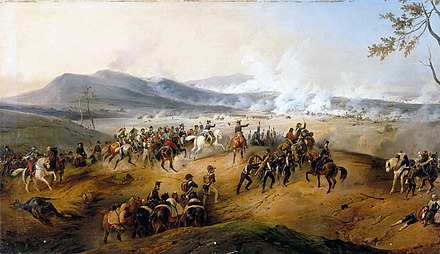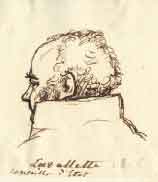
The Battle of Arcole or Battle of Arcola was a battle fought between French and Austrian forces 25 kilometres (16 mi) southeast of Verona during the War of the First Coalition, a part of the French Revolutionary Wars.

The Battle of Bassano was fought on 8 September 1796, during the French Revolutionary Wars, in the territory of the Republic of Venice, between a French army under Napoleon Bonaparte and Austrian forces led by Count Dagobert von Wurmser. The engagement occurred during the second Austrian attempt to raise the Siege of Mantua. It was a French victory, however it was the last battle in Napoleon`s perfect military career as two months later he would be defeated at the Second Battle of Bassano, ending his victorious streak. The Austrians abandoned their artillery and baggage, losing supplies, cannons, and battle standards to the French.

The Battle of Montenotte was fought on 12 April 1796, during the French Revolutionary Wars, between the French army under General Napoleon Bonaparte and an Austrian corps under Count Eugène-Guillaume Argenteau. The French won the battle, which was fought near the village of Cairo Montenotte in the Kingdom of Sardinia-Piedmont. The modern town is located in the northwestern part of Italy. On 11 April, Argenteau led 3,700 men in several assaults against a French mountaintop redoubt but failed to take it. By the morning of the 12th, Bonaparte concentrated large forces against Argenteau's now-outnumbered troops. The strongest French push came from the direction of the mountaintop redoubt, but a second force fell on the weak Austrian right flank and overwhelmed it. In its hasty retreat from the field, Argenteau's force lost heavily and was badly disorganized. This attack against the boundary between the Austrian and Sardinian armies threatened to sever the link between the two allies. This action was part of the Montenotte Campaign.

In the Battle of Rovereto on 4 September 1796 a French army commanded by Napoleon Bonaparte defeated an Austrian corps led by Paul Davidovich during the War of the First Coalition, part of the French Revolutionary Wars. The battle was fought near the town of Rovereto, in the upper Adige River valley in northern Italy.

The Battle of Lonato was fought on 3 and 4 August 1796 between the French Army of Italy under General Napoleon Bonaparte and a corps-sized Austrian column led by Lieutenant General Peter Quasdanovich. A week of hard-fought actions that began on 29 July and ended on 4 August resulted in the retreat of Quasdanovich's badly mauled force. The elimination of Quasdanovich's threat allowed Bonaparte to concentrate against and defeat the main Austrian army at the Battle of Castiglione on 5 August. Lonato del Garda is located near the SP 668 highway and the Brescia-Padua section of Autostrada A4 to the southwest of Lake Garda.

During the Siege of Mantua, which lasted from 4 July 1796 to 2 February 1797 with a short break, French forces under the overall command of Napoleon Bonaparte besieged and blockaded a large Austrian garrison at Mantua for many months until it surrendered. This eventual surrender, together with the heavy losses incurred during four unsuccessful relief attempts, led indirectly to the Austrians suing for peace in 1797. The siege occurred during the War of the First Coalition, which is part of the French Revolutionary Wars. Mantua, a city in the Lombardy region of Italy, lies on the Mincio River.

Johann Mészáros von Szoboszló joined the Austrian army in 1756 and fought the Prussians, Ottoman Turks, and French during a long military career. During the French Revolutionary Wars, he fought in several campaigns. He commanded a division in the 1796-1797 Italian campaign against the army of Napoleon Bonaparte. He was Proprietor (Inhaber) of an Austrian Uhlan regiment from 1792 to 1797 and a Hussar regiment from 1797 to 1801.
Joseph Ocskay von Ocskó joined the army of the Habsburg Empire and rose to the rank of general officer during the French Revolutionary Wars. He fought in numerous actions in the 1796-1797 Italian campaign against the French army commanded by Napoleon Bonaparte. In particular, he led a combat brigade during the first, third, and fourth Austrian attempts to relieve the Siege of Mantua.
In the Battle of Arcole on 15 to 17 November 1796, the French Army of Italy commanded by Napoleon Bonaparte won a victory over the army of Austria led by Jozsef Alvinczi. The battle was part the third relief of the Siege of Mantua in which Alvinczi's army repulsed Bonaparte at the Second Battle of Bassano on 6 November and at the Battle of Caldiero on 12 November. Meanwhile, Paul Davidovich's Austrian Tyrol Corps clashed with Claude Vaubois' French division at Cembra on 2 November. Davidovich defeated Vaubois at the Battle of Calliano on 6–7 November and Rivoli Veronese on 17 November. After Bonaparte's triumph at Arcola, he turned on the Tyrol Corps, beat it at Rivoli on 21 November, and forced it to retreat north into the mountains.

In the Montenotte Campaign between 10 and 28 April 1796 General Napoleon Bonaparte's French Army of Italy broke the link between Feldzeugmeister Johann Peter Beaulieu's Austrian army and Feldmarschallleutnant Michelangelo Alessandro Colli-Marchi's Sardinian army. In subsequent engagements, the French defeated the Austrians, pursued Colli to the west, and forced the Sardinians to withdraw from the First Coalition against France. Actions were fought at Voltri on 10 April, Monte Negino (Legino) on 11 April, Montenotte on 12 April, Millesimo on 13 April, Dego on 14–15 April, Ceva on 16 April, San Michele Mondovi on 19 April, and Mondovì on 21 April.
Anton Lipthay de Kisfalud, also Anton Liptai or Anton Liptay, served in the Austrian army, attained general officer rank, and fought in several battles against the French army of Napoleon Bonaparte during the French Revolutionary Wars.
In the Battle of Rivoli on 14 and 15 January 1797, the French Army of Italy led by Napoleon Bonaparte crushed the main Austrian army led by Jozsef Alvinczi. The battle occurred during the fourth Austrian attempt to relieve the Siege of Mantua. After crippling Alvinczi's army on the 14th, Bonaparte left Barthélemy Joubert and Gabriel Rey to finish off the Austrians and raced south with André Masséna to deal with a relief column led by Giovanni di Provera. On 16 January, Masséna, Pierre Augereau, and Jean Sérurier trapped Provera near the Mantua siege lines and forced his surrender.
The Second Battle of Bassano on 6 November 1796, saw a Habsburg Austrian army commanded by Jozsef Alvinczi fight Napoleon Bonaparte's French Army of Italy. The Austrians repulsed persistent French attacks in a struggle in which both sides suffered heavy losses. The engagement, which happened two months after the more famous Battle of Bassano, marked the first tactical defeat of Bonaparte's career and occurred near Bassano del Grappa in Northern Italy during the French Revolutionary Wars. The action was part of the third relief of the Siege of Mantua during the War of the First Coalition.
In the Battle of Bassano on 8 September 1796, Napoleon Bonaparte and his French Army of Italy routed an Austrian army led by Dagobert Sigmund von Wurmser. Afterward, Wurmser gathered the intact parts of his army and marched for Mantua. On 15 September, the French defeated the Austrians and drove them into the fortress. This raised the numbers of the underfed and malaria-ridden garrison to nearly 30,000 men. These actions and the Battle of Rovereto occurred during the second attempted relief of the Siege of Mantua.
The Battle of Borghetto, near Valeggio sul Mincio in the Veneto of northern Italy, took place during the War of the First Coalition, part of the French Revolutionary Wars. On 30 May 1796, a French army led by General Napoleon Bonaparte forced a crossing of the Mincio River in the face of opposition from an Austrian army commanded by Feldzeugmeister Johann Peter Beaulieu. This action compelled the Austrian army to retreat north up the Adige valley to Trento, leaving the fortress of Mantua to be besieged by the French.
Karl Philipp Sebottendorf van der Rose enrolled in the Austrian army at the age of 18, became a general officer during the French Revolutionary Wars, and commanded a division against Napoleon Bonaparte in several notable battles during the Italian campaign of 1796.

The Battle of Verona was fought on 18 October 1805 between the French Army of Italy under the command of André Masséna and an Austrian army led by Archduke Charles, Duke of Teschen. By the end of the day, Massena seized a bridgehead on the east bank of the Adige River, driving back the defending troops under Josef Philipp Vukassovich. The action took place near the city of Verona in northern Italy during the War of the Third Coalition, part of the Napoleonic Wars.
The Battle of Voltri was an engagement occurring on 10 April 1796 during the French Revolutionary Wars and taking place in Voltri, a suburb of Genoa, Italy.

The Battle of Tarvis was fought during March 21-23, 1797 near present-day Tarvisio in far northeast Italy, about 12 kilometres (7 mi) west-by-southwest of the three-border conjunction with Austria and Slovenia. In the battle, three divisions of a First French Republic army commanded by Napoleon Bonaparte attacked several columns of the retreating Habsburg Austrian army led by Archduke Charles, Duke of Teschen. In three days of confused fighting, French divisions directed by André Masséna, Jean Joseph Guieu, and Jean-Mathieu-Philibert Sérurier succeeded in blocking the Tarvis Pass and capturing 3,500 Austrians led by Adam Bajalics von Bajahaza. The engagement occurred during the War of the First Coalition, part of the French Revolutionary Wars.





















